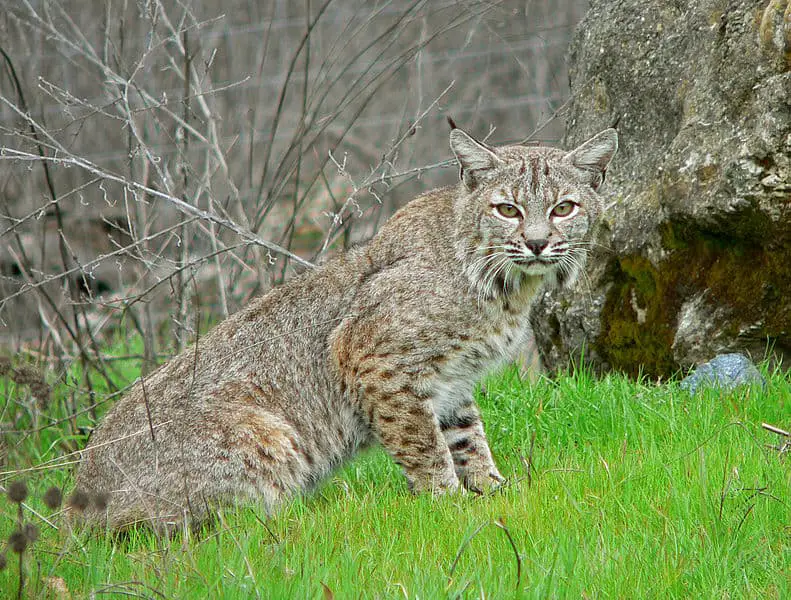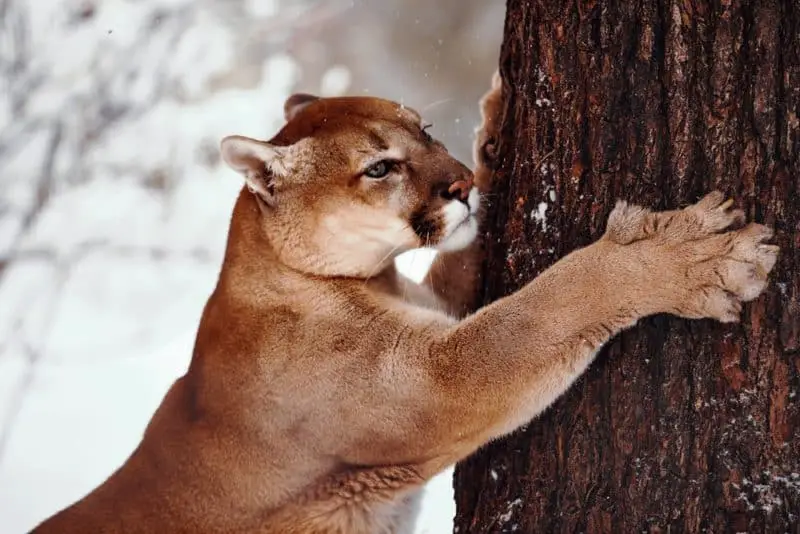Mountain lions and bobcats are the two wild cat species that live in California. These two cats share much of the same habitat, whether desert, mountain, or urban, throughout the state.
California mountain lions (Puma Concolor)
Mountain lions are found throughout the Americas, including parts of all three continents. Consequently, they have many regional names. In 1834, their scientific name was changed from Felis concolor to Puma concolor. Some common names for mountain lions are cougar, catamount, Florida panther, painter, and puma.
What Do Mountain Lions Look Like?
General Appearance
- A mountain lion resembles a domestic cat with short tan hair and a lean, muscular build.
- Mountain lions are much larger than domestic cats, though. One of these feline predators is 11 to 26 times larger than a typical house cat.
Body Structure
- Head: Rounded with upright, oval-tipped ears.
- Body: Longish, muscular, feline.
- Tail: Long, and muscular. Their proportionately long tail accounts for nearly one-third of their total length.
- A fun fact is that they use their tails as a counterbalance and a rudder. This is handy as they scramble over difficult terrain or make sudden directional changes.
Coat and Coloration
- Primary Color: Light brown, short, and coarse hair covers most of the body.
- Distinctive Markings:
- Black on the area around the nose, ear tips, and tail tip.
- White fur on the belly, upper lip area, lower lip, and chin.
- Dark hair is scattered on their back. This can vary with geographic location.
Size Differences Between Males and Females
- Adult Males:
- Typically, 30–40% larger than females.
- Weigh between 110–180 pounds (50–82 kg), with rare individuals over 200 pounds (91 kg).
- Length: 6–8 feet (1.8–2.4 meters) from nose to tail tip.
- Adult Females:
- Weigh between 80–130 pounds (36–59 kg).
- Length: 5–7 feet (1.5–2.1 meters).
Mountain Lion Comparison with Other Wildcats
- Mountain lions are the Fourth largest wildcat in the world.
- They are smaller than the African lion, the tiger, and the jaguar but larger than leopards.
- After the jaguar, they are the second largest wild cat in the Americas.
Unique Characteristics
- Purring: Mountain lions can purr but can’t roar. This distinguishes them from the four big cats mentioned above and places them in a different genus.
- Taxonomic Classification:
- They are part of the Felis genus due to their inability to roar.
- They are distinguished from “big cats” like African lions and leopards in the Panthera genus, which can roar but not purr.
Where Are Mountain Lions Typically Found?
Range Across the Americas
- Mountain lions range through North America, Central America, and South America.
- Their range extends from the Yukon Territory in Canada to the southern tip of Argentina.
Major Regions by Country
- Canada:
- The largest populations are found in British Columbia and Alberta.
- Their population is increasingly sparse as you travel further north into Canada.
- United States:
- In the U.S., cougars are primarily confined to the states west of the Missouri and Mississippi Rivers.
- They are also found in Florida. In the Sunshine State, they’re called “Florida Panthers.”
Mountain Lion Habitat in California
- According to the California Department of Fish and Wildlife, an estimated 4,000 to 6,000 mountain lions live throughout California.
- Diverse Habitats:
- Mountain lions inhabit various environments in California, including deserts, mountains, forests, and even urban areas.
- They favor steep, rocky terrain with abundant cover.
- The availability of prey animals is a deciding factor in where mountain lions will be found. An adult cougar needs to consume around 6,000 calories per day.
- Notable Areas:
- Northern California: The Klamath and Cascade ranges.
- Southern California: The Transverse Ranges, such as the Santa Monica Mountains.
- Yosemite National Park: A prime habitat with an abundant deer population, which supports a healthy mountain lion presence.
- Urban Areas: If cougars’ requirements of cover and prey abundance are met, they can even live near urban areas. Griffith Park in Los Angeles was known to harbor a male mountain lion that researchers dubbed P-22 for at least 10 years. Wildlife officials captured and euthanized P-22 in 2022. However, a May 22, 2024, Los Angeles Times article featured a photo of a new male mountain lion in the Griffith Park area.
Territorial Behavior
- Mountain lions are solitary animals. An individual animal requires a large home range.
- Males: Home ranges exceed 100 square miles, sometimes reaching up to 250 square miles.
- Mark territory with claw marks on trees and by scratching up and scent-marking piles of leaves or pine needles.
- Territorial Conflicts: Adult males may fight to the death to protect their range from other males.
What do mountain lions eat?
Mountain lions are opportunistic predators that hunt mostly nocturnally. They stalk their prey, mainly deer, from behind. This could be a Columbian black-tailed deer or a mule deer in California.
Diet of Mountain Lions
On average, a mountain lion kills a deer or the equivalent of a deer in biomass once a week. Their menu is not restricted exclusively to deer, though. In California, they also prey on the following:
- Elk
- Desert bighorn sheep
- Pronghorns
- Feral horses
- Coyotes
- Raccoons
- Birds
- Rodents
- Feral pigs
- Porcupines
- Skunks
- Miscellaneous reptiles
- Small pets
- Domestic livestock
- Any other native wildlife they can catch.
Do mountain lions ever harm humans?
I’ve taken much of the following section from another of my blog posts, “Are Mountain Lions Dangerous?” It can be found here.
Fatal mountain lion attacks on humans are extremely rare. There are only 20 records of fatal mountain lion attacks on humans in all of North America in the last 100 years. Don’t let that fact lull you into a complete sense of false security, though. There have been many more mountain lion attacks over the years that didn’t result in a fatality. Mountain lions are, in fact, dangerous.
A mountain lion is a formidably tough wild predator. It can run 40 to 50 miles per hour for short bursts and leap 18 feet vertically and 40 feet horizontally to catch its prey. These ninja-like predators typically stalk their prey from behind and then leap on an animal’s back. With its powerful jaws, it crushes its cervical spine or larynx. It has a bite force of 750 pounds per square inch.
Some factors that cause mountain lions to attack humans
Most of the time, mountain lions use their ghost-like skills to avoid human contact. On rare occasions, though, they attack humans. Below are a few of the reasons why.
- If the cougar has an injury or impairment that prevents it from killing its normal prey, it’ll be more likely to consider a person as potential prey.
- Male mountain lions engage in fights for territory. Some of their battles are to the death. A percentage of cougar attacks on humans are perpetrated by hungry semi-juvenile toms that have been kicked out of territories with a more abundant food supply.
- Scientific data suggests that mountain lions orphaned at a young age are more likely to attack humans. This is possibly because they missed the part of their training where their mothers taught them that humans should be feared.
If a mountain lion is stalking, you
- Never run away. According to a Multidisciplinary Journal of the Interactions of People and Animals, those who try to run away when they encounter a mountain lion put themselves at greater risk of sustaining serious injuries and even death. Running away triggers a lion’s instinct to chase.
- Stay as calm as you can. Panic is your enemy. In a survival situation such as this, a cool head will put you at a better advantage.
- Speak firmly in a loud voice but avoid a high-pitched tone or screaming
- You need to hold your ground when the cat is coming towards you and slowly back away when it pauses its approach
- Stand upright. Avoid bending over or crouching down as much as possible, as this puts you in the vulnerable position of appearing like a small, four-legged animal that can easily become prey.
- Open your jacket if you’re wearing one to appear larger. and wave your arms slowly to give yourself the appearance of having as much size as possible as you back away slowly. You can also throw rocks, sticks, or other objects at the lion.
- If you’re walking with a child, pick them up and hold them in your arms.
If you’ve done all the above, there’s still that small chance that you’ll still be attacked by the mountain lion. You need to be mentally prepared for this. At this point, do not panic and freeze up. In order to survive, you’ll need to fight back with as much aggression as you can muster.
Historical accounts show that people have successfully fought mountain lions off with their bare hands, sticks, rocks, garden tools, or any other weapon within reach. You already have a ready-made weapon if you’re using a walking stick. Target sensitive areas such as the eyes and nose, and hit as hard as you can! You should also try to remain standing if possible. You’ll lose some of your advantage on the ground. If you get knocked down, try as hard as possible to protect your neck and head as you continue to fight back.

California bobcats (Lynx rufus)
Quick Facts
- Range: Southern Canada to Southern Mexico, exclusively in North America.
- Size: 15–35 pounds; 2–4 feet long.
- Lifespan: Average 10–12 years in the wild.
- Key Characteristics: Short tail, spotted coat, tufted ears.
Bobcats live only in North America. Their range begins in southern Canada, about where the range of their close relative, the Canada lynx, begins to dwindle out and extends south into southern Mexico.
A bobcat is much smaller than a mountain lion. Bobcats are small wild cats. Bobcats that are a little on the small side are not much bigger than large domestic cats such as Maine Coon Cats.
Physical Characteristics
- A bobcat is 2 to 4 feet long and weighs about 15 to 35 pounds. A Female bobcat is quite a bit smaller than a male.
Appearance:
- Tail: These animals have a short, “bobbed” tail with a black tip.
- Coat: Their fur is usually gray to brown, with dark, mottled black spots on their bodies. They also have black stripes on their inner forelegs and tails.
- Body Shape: From a side view, you will notice that a bobcat is slightly higher in the rump than at the shoulders. Bobcats and lynx have long hind legs in proportion to their forelegs.
- Ears and Face: Their ears have black tufts of hair at the tips. Their whiskered face seems broader due to their long, ruffled facial hair and whiskers. Their eyes are yellow or green, and they have vertical slit-shaped pupils.
Like mountain lions, bobcats live a solitary existence most of the time. You’d likely only see two adult bobcats together during the mating season. Female bobcats breed once a year. If they successfully breed, they will have an average of three kittens. After breeding, the male’s role is complete. He goes off to search for more females to mate with. Only the female bobcat cares for the kittens and teaches them how to survive. When they are about a year old, the young bobcats are on their own.
Bobcats are fierce. If you get one cornered, you’ve got a semi-dangerous animal on your hands. It will hiss, growl, and spit like one of the nastiest house cats you’ve ever encountered, only much worse. They mean it, too. They have to be tough and mean to survive.
Primary Diet
- Small Mammals: Their main diet consists of smaller animals, particularly:
- Jackrabbits
- Cottontail rabbits
- Snowshoe hares
- Mice
- Squirrels
Additional Prey
- Larger Animals (seasonal or situational):
- They occasionally hunt larger prey, such as small deer. However, they are more apt to pursue deer in the winter when the animals are bogged down in deep, crusted snow.
- Other Prey:
- Reptiles and amphibians
- Birds, carrion, and small pets or domestic animals if near human habitation.
Hunting Behavior
- Bobcats are agile and adaptive hunters.
- Stalking and Ambush: Skilled at stalking and ambushing prey in dense vegetation.
- Quick Reflexes: Known for fast, precise movements, which help when dealing with dangerous prey like rattlesnakes.
Interesting Fact
- Even though bobcats are not immune to venom, they successfully hunt rattlesnakes by pinning their heads down and delivering a quick bite to the spine.
Where Do Bobcats Live in California?
Wide Distribution Across Diverse Habitats
Bobcats are found throughout California in various ecosystems, from mountainous and semi-desert regions to oak, pinyon-juniper, and mixed conifer/deciduous forests. They are highly adaptable and can thrive in diverse environments across the state.
Near Urban Areas and Residential Neighborhoods
While bobcats prefer wild habitats, they are more likely than mountain lions to venture close to human residences. Their presence is often detected near urban areas, especially in southern and northern California, as they can adapt to regions with high human activity.
Bobcat Populations in Southern California
Urban Landscapes and Suburban Adaptations
In Southern California, bobcats are known to be in and around the Simi Hills, Santa Monica Mountains, and Santa Susana Mountains. Urban bobcats can even be spotted in Los Angeles, though they are elusive and primarily active during dawn and dusk.
Encounters and Safety Tips
If you spot a bobcat near your home, respect its space. If it is cornered inside a garage or enclosed area, leave a clear exit route and move back to allow it to leave naturally. Should the bobcat linger, contact the California Department of Fish and Wildlife for assistance.
Bobcat Habitats in Northern California
Forested Regions and Urban Outskirts
Northern California is home to bobcats in the expansive redwood forests, the Klamath, Cascade, Warner, and Sierra Nevada ranges. Bobcats are also occasionally seen in urban areas such as the San Francisco Bay area. For example, visitors to Yosemite National Park might glimpse these elusive cats hunting even during the day.
Nocturnal Nature but Visible Daytime Sightings
Though bobcats are primarily nocturnal or crepuscular, their adaptability allows for occasional daytime activity, particularly in less disturbed forest regions.
Final Thoughts
California is a large, ecologically diverse state. Both the Mountain lion and the bobcat have adapted to thrive in a variety of ecosystems from the north end to the south end of the state. What’s more, they have learned to adapt and thrive in areas with habitat loss due to urbanization, too.
Recent Posts
The only venomous snakes in Washington State are Northern Pacific Rattlesnakes. The Northern Pacific Rattlesnake (Crotalus oreganus oreganus) is a sub-species of the Western Rattlesnake. Anyone...
Skunks are not classified as true hibernators. But they go into a state of torpor when the weather gets cold. Skunks are light sleep hibernators, along with opossums, bears, and raccoons. ...

